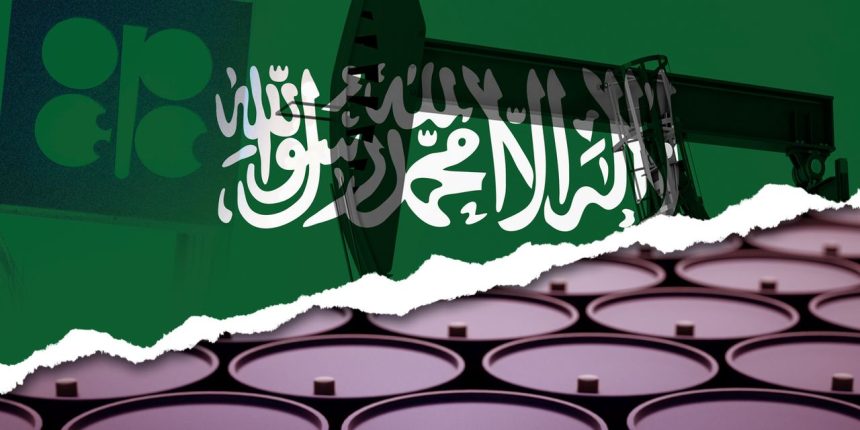Oil prices have climbed to their highest levels of the year, buoyed in part by news that Saudi Arabia and Russia have extended their production cuts to the end of the year, even as demand uncertainty continues to hang over the market outlook.
Some analysts believe the move by some of the world’s biggest oil producers may lift U.S. benchmark West Texas Intermediate crude above $100 and beyond in the months ahead,
Saudi Arabia said Tuesday that it will extend its voluntary cut of 1 million barrels a day to the end of the year, according to the country’s official press agency, citing an official source from the Ministry of Energy.
Separately, Russia’s Deputy Prime Minister Alexander Novak announced that his country will extend its additional voluntary cut in oil supplies by 300,000 barrel a day until the end of December.
The extension of the output reductions is “very bullish’ and means that oil supplies will continue to tighten into the end of the year,” Phil Flynn, senior market analyst at The Price Futures Group, told MarketWatch.
The Organization of the Petroleum Exporting Countries and their allies, together known as OPEC+, didn’t want to “keep the drama up month after month, having the market speculate on whether they would keep production cuts in place,” he said. Three three-month extension is “really sending a message that they have gained control over the market.”
On Tuesday, global benchmark Brent crude for November delivery
BRNX23,
BRN00,
traded above $90 a barrel to the highest levels year to date. It settled at $90.04 a barrel on ICE Futures Europe, up $1.04, or 1.2%. U.S. benchmark West Texas Intermediate crude for October delivery
CLV23,
CL.1,
rose $1.14, or 1.3%, to $86.69 a barrel on the New York Mercantile Exchange, settling at their highest since Nov. 15.
Read: Energy stocks lead S&P 500 again, as Saudi Arabia, Russia extend crude-supply cuts
Period of lower oil demand
The Saudis’ month-to-month production cuts had been taking place during the strongest demand season of the year — the summer, said Peter McNally, global sector lead for industrials, materials, and energy at Third Bridge.
However, demand historically starts to decline in September and refinery turnarounds begin, lowering physical demand for crude, he said.
Saudi Arabia is well aware that oil market is transitioning into a low-demand period of the year, said Matt Smith, lead oil analyst, Americas, at Kpler, and having already made production cuts for three months — July through September — it believes additional cuts are needed to support prices into year-end.
“The quandary becomes whether the kingdom is willing to keep cutting exports and losing market share into 2024 if Brent crude remains below $90 a barrel,” Smith told MarketWatch.
Technical moves
The climb for oil follows bullish technical moves in prices.
Both front-month WTI and Brent crude futures formed so-called golden crosses on Aug. 17, according to Dow Jones Market Data. That happens when a short-term moving price average crosses above a long-term moving average.
Read: No August swoon for oil prices. Here’s why crude bounced back.
Oil prices have rallied from key support levels, suggesting that the correction is over and prices may rally in the months ahead, said Paul Ciana, technical strategist at BofA Securities, in a note dated Monday.
WTI oil found support when retesting lows in the $62s this year, he said, with prices rallying from this point and traders buying the August dip. The relative strength index, a momentum indicator, has turned up and other technical signals point to a “constructive big picture set up for oil prices” heading into the fourth quarter of this year to the second half of 2024, said Ciana.
“This summer turn up in prices has gained momentum,” he said, and last week, prices also closed at their highest levels this year, “breaking resistance and suggesting oil can rally to $100-102″ a barrel.
Political push
Meanwhile, the Saudis’ decision appears somewhat political in nature as the move will continue to flush short sellers and bearish speculators out of the market, said Kpler’s Smith.
He also pointed out that the total additional voluntary cuts announced by Saudis will total 180 million barrels — the same volume the U.S. chose to release from its Strategic Petroleum Reserve last year.
As of Sept. 1, oil in the SPR totaled 350.3 million barrels, according to the U.S. Energy Department. Last month, it fell to its lowest level since 1983, based on data from the Energy Information Administration.
U.S. oil prices are back above $85 and quickly approaching $90, The Kobeissi Letter said on X Tuesday. The U.S. reserve “can no longer save the day” for oil consumers, it said, adding that the SPR has seen a roughly 43% drop in two years.
Overall, the move is basically a “slap in the face to the United States,” said Flynn of The Price Futures Group. Last year’s historic release from the SPR was made to help lower oil prices for consumers.
‘Right move’?
Still, whether the Saudis’ production cut extension is the right move, remains to be seen, said McNally of Third Bridge.
The market comes down to China, where demand has underwhelmed for more than a year, while global inventories have reversed and moved lower this summer as a result of output cuts and solid demand elsewhere, he said.
Stewart Glickman, energy equity analyst at CFRA Research, said the production cut extensions are the “right move if you are a producer,” but for the oil market, risks include weakness in the Chinese economy, or a U.S. recession, which would both weigh on global energy demand.
“There’s a point where more cuts are too much, but that point is probably if WTI prices go north of $120 [a barrel], and we’re not there yet,” said Glickman.
Oil futures, meanwhile, are experiencing backwardation — a situation where futures contracts expiring in later months are trading lower than current prices.
Backwardation, McNally said, is a “signal of greater spare capacity that could come back in the future, putting pressure on forward prices.”
He pointed out that Saudi production is “at its lowest level in years in order to achieve the prices and balances that we are seeing today.”
Ultimately, Saudi Arabia will “look to reclaim some [oil market] share in the future,” he said, implying a rise in Saudi output.
$100 oil
Still, The Price Futures Group’s Flynn believes the risk of $100 a barrel by the end of the year have “gone up markedly” since the output cut announcements by Saudi Arabia and Russia.
The “possibility of increasing supply draws in the coming months and the possibility that this winter might not be as warm as last could send us to that [price] mark before the end of the year,” he said.
“Talk of slowing Chinese oil demand has not materialized” and for now, the trend for oil is much higher, said Flynn.
Read the full article here




